
What Is a Marketing Plan And How To Create One [+Free Template]
Every business, regardless of industry, needs a solid marketing plan to highlight its marketing objectives, estimate the necessary costs, and keep track of the strategic goals it sets.
However, brands usually try various marketing tactics simultaneously and even go over budget to get the best results. And this is exactly what you’d hate to happen to you.
So how can you avoid that? Today, we’ll show how to create an effective marketing plan that works for every business. But first, what is a marketing plan? Let’s get that straightened out.
Disclaimer: You can get a copy of our marketing plan template to make yours as you read.
What Is a Marketing Plan?
A marketing plan is a roadmap outlining the way businesses set their marketing goals, how they execute them, as well as the way they track their marketing strategy.
In a nutshell, it provides a clear view of all your marketing activities, including seven important sections:
- A summary of your company
- The business initiatives set by your team
- Your target audience and potential customers
- The marketing strategies and tactics you’ll adopt
- Estimated budget and financial considerations
- The marketing channels you’ll target
- The marketing technology you’ll require
All these, along with the Key Performance Indicators (KPIs) you need to measure results, will help you structure a viable, clear, and efficient marketing plan.
Before we get to it, though, let’s explore the difference between a marketing plan and a strategy.
Marketing Plan vs. Marketing Strategy
Sometimes, these two terms are used interchangeably. However, they have their differences.
A marketing strategy illustrates how a business will attempt to accomplish a certain goal or mission in the long-term. It includes the channels, campaigns, content, or software/tools used to reach those goals and measure success.
On the other hand, a marketing plan involves the specific steps (daily, weekly, etc.) required to achieve the goals of the marketing strategy. With such a tool, a business plan is set to execute, and measure their activities within a specific timeframe.
Essentially, it’ s a detailed framework dictating which marketing strategies the company will use. Besides that, this roadmap helps connect each strategy to your overall digital marketing operations and business goals.
Care to see an example? If a brand’s goal is to boost brand visibility, their marketing strategy could involve organizing giveaways on key social media channels. And it should highlight why this tactic could serve this goal.
Whereas the marketing plan tells team members how to implement the strategy. In other words, detail specific actions, channels, content, and tools that they’ll employ.
Now let’s go through the different marketing plan types you can use.
Types of Marketing Plans
How detailed you want your marketing plan to be? Depending on the answer, you can opt to craft one for the whole year, semester, and quarter, or write separate plans for each individual channel you wish to target.
Here are the most common types of marketing plans to create.
- Annual, biannual, and marketing plan (general): These plans let you see every marketing activity at a glance, from the company mission and unique selling points (USPs) to your SWOT analysis and marketing channels.
- Content marketing plan: Such a plan sheds light on the different tactics, strategies, and campaigns you can use to help your business reach its goals content-wise. It can also feature an editorial calendar for your team.
- Social media marketing plan: This one contains specific social media tactics to establish your presence on social media platforms, including which campaigns to run, people in charge, posting schedule, even crisis management strategies.
- Paid marketing plan (demand generation): This type of marketing plan involves your paid marketing strategy, such as search ads, paid social media ads, email marketing strategy, and more.
- Product launch marketing plan: When you’re about to launch a new product, it takes planning. Think of a detailed value proposition, prelaunch promotions, post-launch campaigns and offers, and follow up targeting. This is a roadmap for your strategies to promote your product so it doesn’t go unnoticed.
- Growth marketing plan. With this long-term plan, you outline strategies aimed at achieving brand growth. You’ll have to decide on the tactics, tools, and channels you’ll experiment with to expand your reach.
- Offline marketing plan. Not every targeting activity has to be online. In-store promotions (if you own a physical store), public relations, print advertising, in-person events work great for prospects who prefer the old-fashioned approach. Also, for businesses that want to gain a share of the local market.
Now that we got the basics covered let’s create your marketing plan.
How To Write Your Marketing Plan Step-By-Step
Before we get into the essentials, you need to get our template. Once you do, make a copy, fill in your company’s details like we did with our fictional company, and follow our lead.
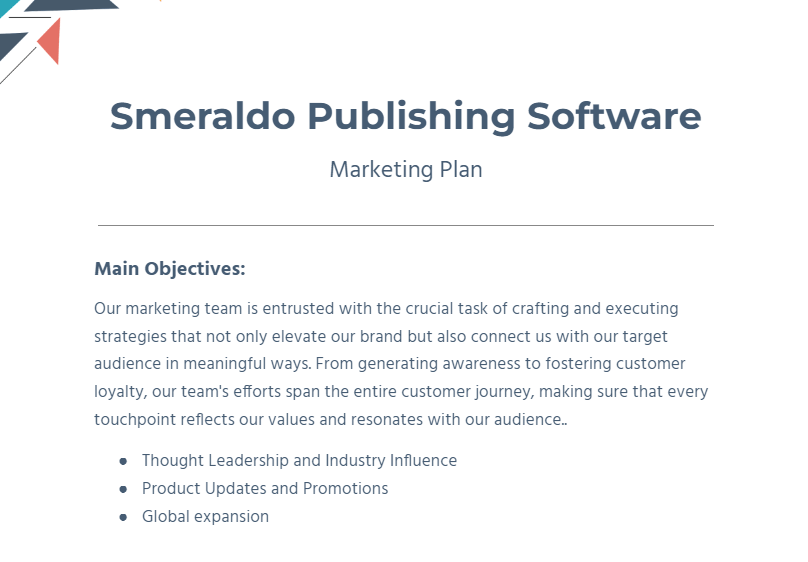
Now, here are the steps to take for a clear and effective marketing plan.
1. Business Summary
What goes at the beginning of a marketing plan? Your business or executive summary, meaning a brief company overview. It introduces readers to your company objectives and mission, marketing achievements, and other key takeaways.
The point is to get your team members and other stakeholders excited to explore your marketing plan. That’s why your executive summary should be simple and to the point.
Here’s what to include in it:
- Simple marketing goals
- Company achievements/milestones
- Future plans
- Facts relevant to your brand
You don’t need to delve into specifics, just critical information that helps people envision your goals. Also, keep in mind that your summary helps set the tone for your marketing plan. So, think carefully about what tone fits your brand best.
Below, you can see an example of a publishing software company:
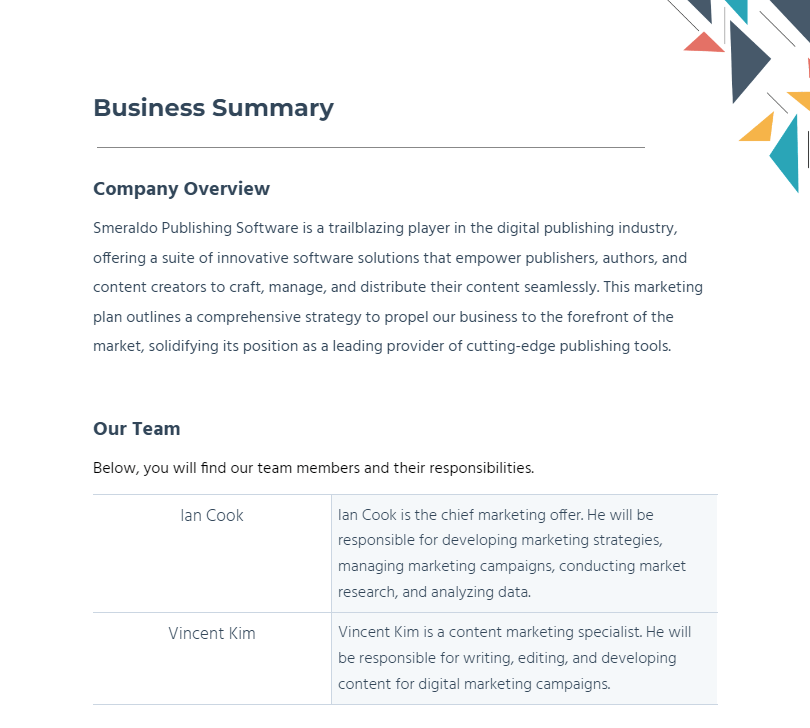
Moreover, your SWOT analysis is also found in this section, so create your SWOT grid and add your business strengths, weaknesses, opportunities, and threats here.
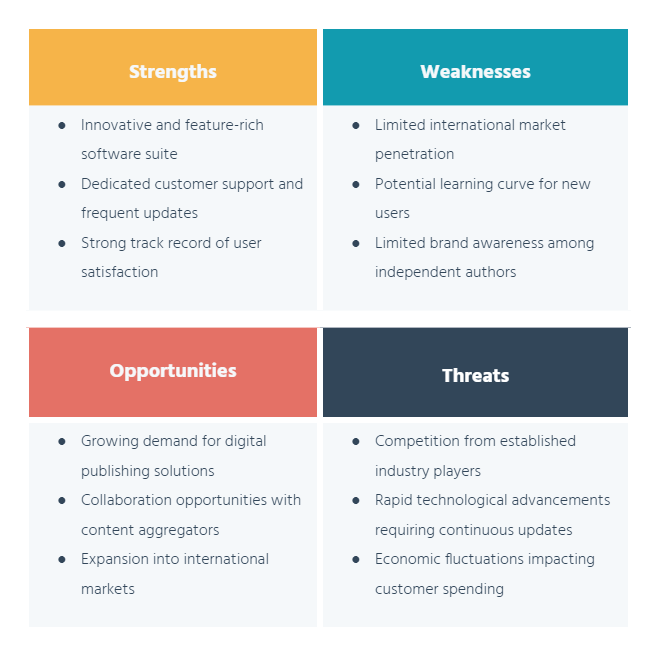
Before you start, determine the scope and context of your analysis, too. Are you evaluating a business, a specific project, a product, or a marketing strategy?
Clarifying the purpose is the first step in crafting an effective grid for your plan. To present your market research, consider using a SWOT analysis template. With it, you can easily highlight your company’s strengths, weaknesses, opportunities, and threats.
2. Business Initiatives
Moving to the next section of your marketing plan, we’ll find your business initiatives.
Here, you need to define the purpose of each goal and determine the metrics to measure its success.
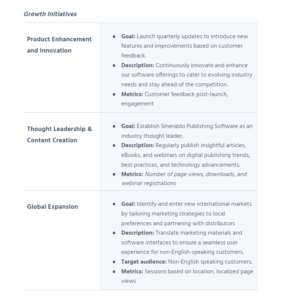
Business initiatives can be explained in full or kept short depending on how you approach your marketing plan. To help you, here are a few steps to create yours:
- Clearly define your business initiative: Write a clear and concise description of the initiative, stating the goal.
- Link to your marketing goals: Highlight how each of your initiatives aligns with your broader marketing objectives to establish its strategic context.
- Specify the target audience: Add the specific target audience or market segment you need to reach with the initiative to build informed strategies.
- Set your Key Performance Indicators (KPIs): Define the metrics you’re going to use to measure success.
Of course, don’t forget to estimate the potential impact on your marketing efforts. A good idea is to try to forecast the return on investment (ROI) to determine beforehand which initiatives to prioritize.
3. Target Market
Tailoring your marketing strategies to address the unique needs of each segment of your customer base helps you set more measurable and smart business objectives for your marketing strategy.
Here, add your target audience and provide some key characteristics to help you identify customer needs.
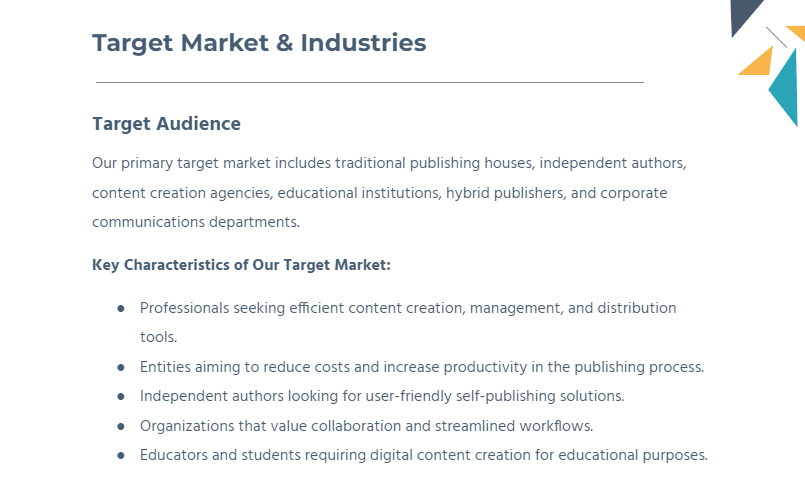
Below, you’ll have to include another important component that’s crucial for creating a comprehensive marketing plan.
Buyer Personas
Buyer personas represent your ideal customers. The majority of businesses have a few types of target customers. So, you may have to identify and craft more than one buyer persona.
By outlining the different buyer personas for your business, you’re one step closer to creating segmented marketing campaigns. Based on this research, you can adjust your marketing materials accordingly to resonate with each segment’s background and behavior.
Moreover, having well-defined and detailed buyer personas influences the messaging used in your marketing content.
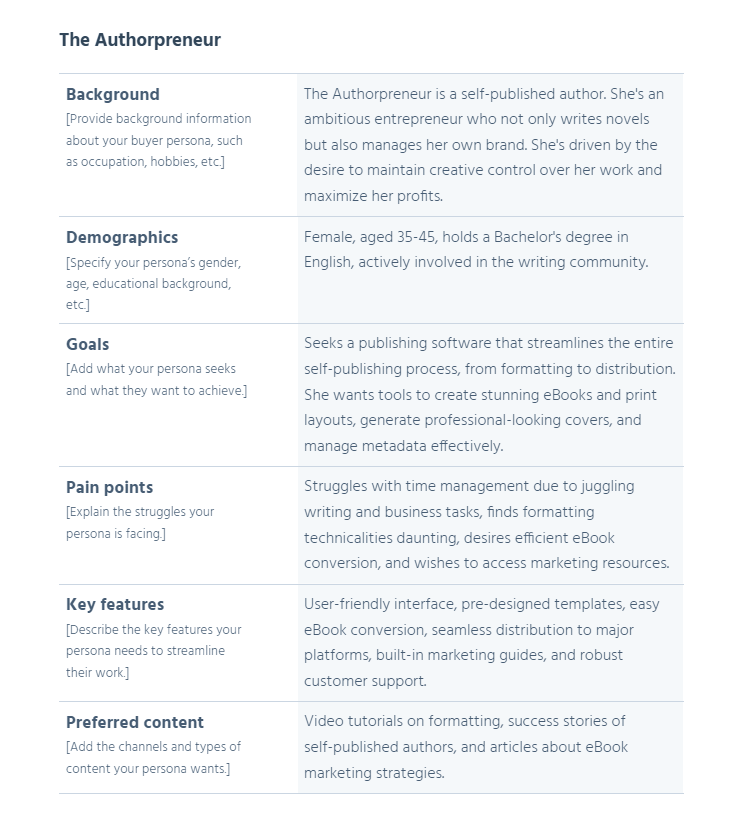
Creating buyer personas is necessary to help you understand your ideal customers, their habits and aspirations. If you haven’t defined yours, follow these steps before adding the information to your marketing plan template:
- Conducting in-depth market research through surveys, questionnaires, or interviews.
- Reaching out to your customers across several touchpoints along the customer journey, including email, website chat, and social media.
- Asking just the right questions to collect the necessary information without tiring your customers.
- Understanding the distinct ways in which your product/service benefits each persona.
- Compiling and analyzing what you collected to create comprehensible customer profiles.
When you have designed your customer personas, you can add the details on your marketing plan. Remember to provide everything you deem relevant: their background, demographics, goals, values, pain points, key features or benefits offered in your value proposition, and preferred content or touch points.
Competitive Analysis
A solid marketing plan should always include thorough research of your business’ competitors.
In this section, you can analyze your current market situation while identifying and studying your competitors. Another key point involves delving deeper into their strengths and weaknesses.
Here are the key points to look through while analyzing competitors:
- Who their leadership and marketing team is
- What their marketing strategy is
- Their email, social media, and SEO strategy plan
- What kind of ads they’re running
- Their most popular products/services
- Their top-performing content, e.g., blog posts
- Their yearly growth (using a marketing tool like Ahrefs)
- The number of customers they have
- Their market share
- Their customers’ feedback
Research thoroughly, and you’ll be able to identify some great opportunities, especially if you are a small business owner who wants to grow the right way. Conducting competitor research is also vital if you own or want to start a blog.
Below, you can add all the information you’ve compiled regarding your competitors, focusing on the products/services they offer and their strengths and weaknesses.
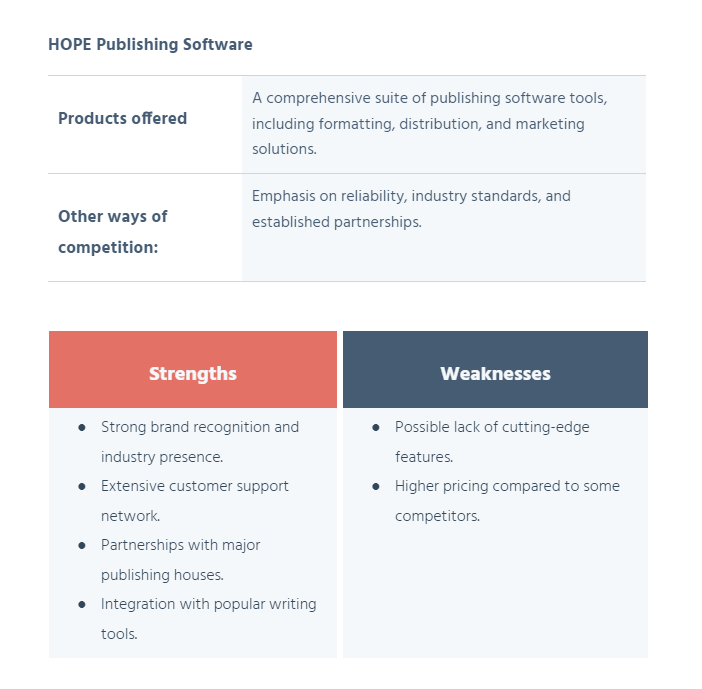
4. Market Strategy
There are some key considerations when creating your market strategy. To have a comprehensive plan for your business, make sure you research current industry trends and your target audience.
To complete it, make sure you:
- Define your goals and conduct a SWOT analysis to discover what you can use and improve
- Understand your target market to adapt your strategy based on changing customer needs so you can choose the right segments to target
- Analyze the competitive landscape and identify their strengths and weaknesses
- Develop your unique value proposition (UVP) to highlight the benefits of your product or service
After performing the above, it’s time to create your market strategy. As time goes by, you can optimize it based on feedback from your team and customers.
We completed our template using the 6 Ps of marketing, the backbone of a any strategy built with customer needs in mind. First we’ll describe product and pricing.
Product & Pricing
To get things started, use our template copy to guide you through the process. For the product section, you need to add:
- Product/Service description: Briefly describe your product or service so consumers know exactly what you’re selling.
- Key features: Highlight what sets your offering apart, e.g., quality, design, or a groundbreaking feature. Basically, everything that explains why it is a gamechanger.
- Value proposition: Clearly state the value your product/service brings to the target market. What pain point does it solve for your buyer personas?
For the pricing, you need the following:
- Pricing model: Describe your pricing structure in a clear and concise way.
- Competitive pricing: How your pricing compares to competitors. For instance, it might be through tiered pricing, early-bird discounts, or any strategy that would appeal to prospects.
- Value-Based pricing: Explain how your pricing is justified by and balanced with the value you offer.
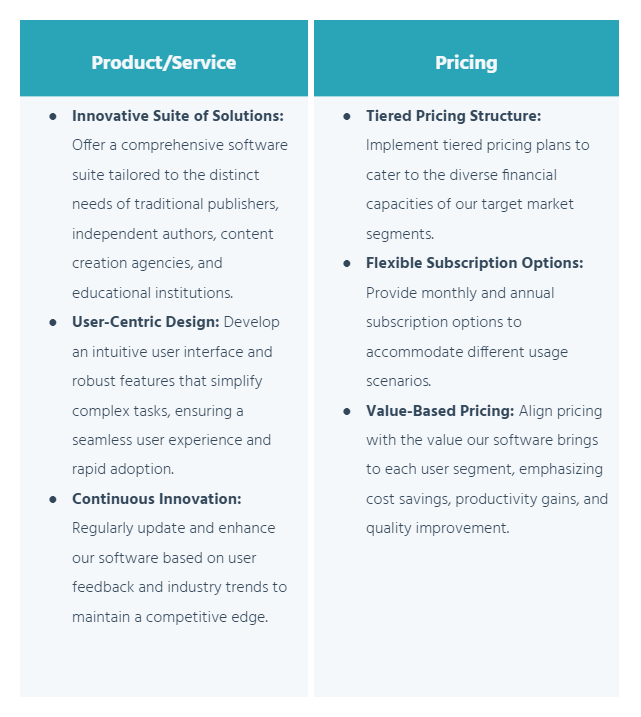
Promotion & People
In the next two sections, you need to describe the tactics you’ll use to promote your product/service and the team responsible for running everything smoothly.
More specifically, here are the elements required for the Promotion table:
- Marketing channels: List the channels you’ll use to reach your target audience, perhaps combining digital and traditional marketing methods.
- Content strategy: Plan how you’ll create and distribute valuable content that clearly communicates your product/service benefits.
- Advertising and promotion: Outline any paid advertising, promotional campaigns, or publice relation efforts you need to invest in.
Now let’s see what to include in the People and Team section:
- Roles and responsibilities: List key team members and their roles in designing, delivering, and advertising your products/services.
- Skill sets: Describe the skills and expertise of your team and how they will contribute to a successful execution.
- Training and development: Consider how you’ll train and educate your team so they can meet customer needs effectively.

Process & Place
Lastly, you should write down your process and place (distribution) methods.
The Process section should list the following components:
- Timeline: Outline the timeline for executing the strategy by highlighting your short-term (0-6 months), mid-term (6-12 months), and long-term goals (1+ years).
- Project management: Explain how you’ll manage the execution process, involving activities from manufacturing to customer service.
- Feedback and adaptation: Decide on the most effective ways to gather feedback. for example using email surveys. Also, keep making adjustments for a smooth customer experience.
To create the Place table, keep these in mind:
- Distribution channels: Describe which channels you’ll use to distribute your product/service so they reach the right people at the right time.
- Sales strategy: Explain your sales approach, e.g., direct sales, partnerships, wholesales.
- Customer relationship management: Determine how you’ll maintain strong relationships, aiming at customer satisfaction and loyalty.
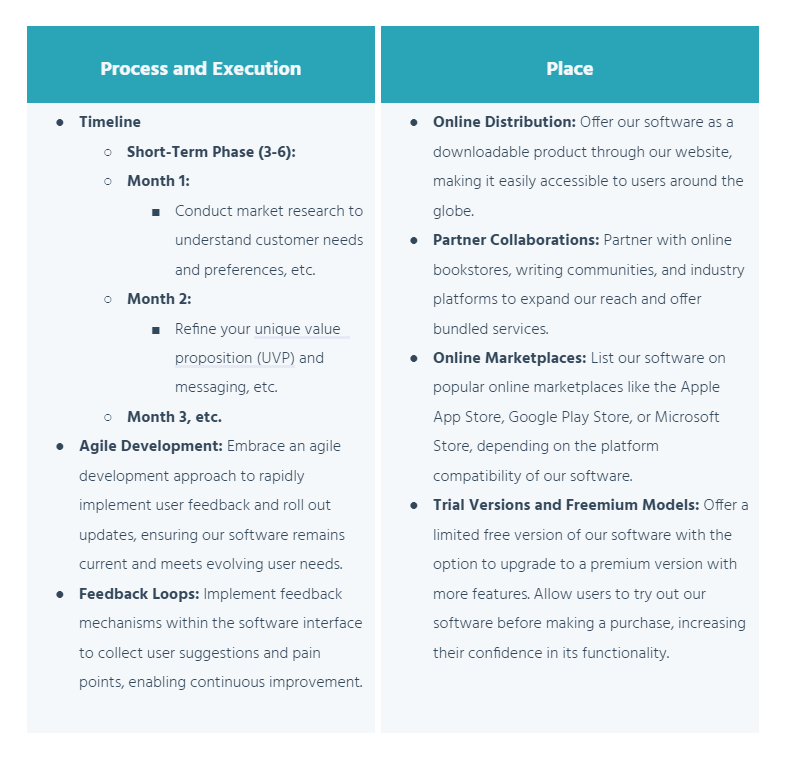
Each of these strategy components is useful on its own. But what’s key here is to carefully think how they’ll play together to create a complete marketing picture.
5. Budget
Another thing to consider when building your marketing is your budget. It might not be a creative part of the process, but it sure is a crucial one. That’s because it allows you to allocate resources in the most suitable way from day one.
Not setting a clear budget upfront might lead to overspending or setting wrong priorities. Therefore, budget forecasting prevents you from losing sight of the overall financial picture during implementation.
While your team may be leveraging many free channels and platforms, there will be “hidden” expenses a marketing team will have to account for. So, you might want to invest in solid business budgeting software to track spending, create budgets, and monitor progress.
Let’s give you a few examples of what your marketing plan cost may include:
- freelance fees
- sponsorships
- tools and platforms
- new marketing hires and other staffing costs
- cost for collaborations and partnerships
- offline advertising efforts
You can add everything in the Budget section and provide the estimated cost (if you don’t have the actual price yet.)
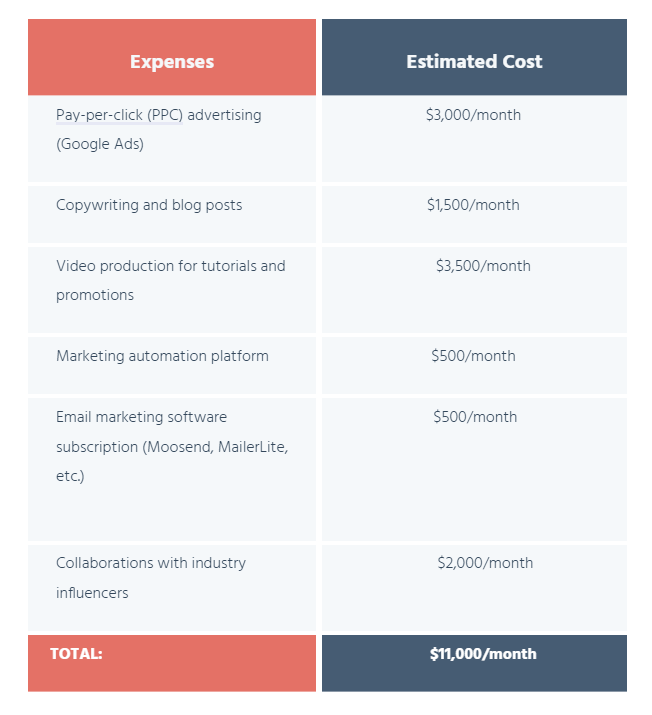
6. Marketing Channels
Choosing the right marketing channels for your business requires a strategic approach that considers your target audience, marketing goals, budget, and your value proposition.
To make an informed decision, you need to:
- Identify and understand your ideal customers. Consider their demographics, psychographics, online behavior, preferences, and where they spend their time.
- Determine your available budget for marketing activities since some channels and platforms may be costlier. Add to that any additional costs for content creation, for example if you’ll need to hire a freelancer for content creation in specific channels.
- Research various marketing channels to understand their strengths, weaknesses, and suitability for your business. Some popular channels include email marketing, SEO, social media, affiliate marketing, content marketing, and paid advertising.
- Consider the nature of your product or service. For example, visual products may perform well on Instagram, while B2B services might put their money in LinkedIn .
These are some of the essential things you need to consider before choosing the right marketing channels for your business. Getting the wrong tools for the job will affect both your operations and your budget. So, do the necessary research before you commit.
Below, you can highlight the channels you’ll use, providing a small description of their purpose and goal and the metrics you’ll track to measure their success.
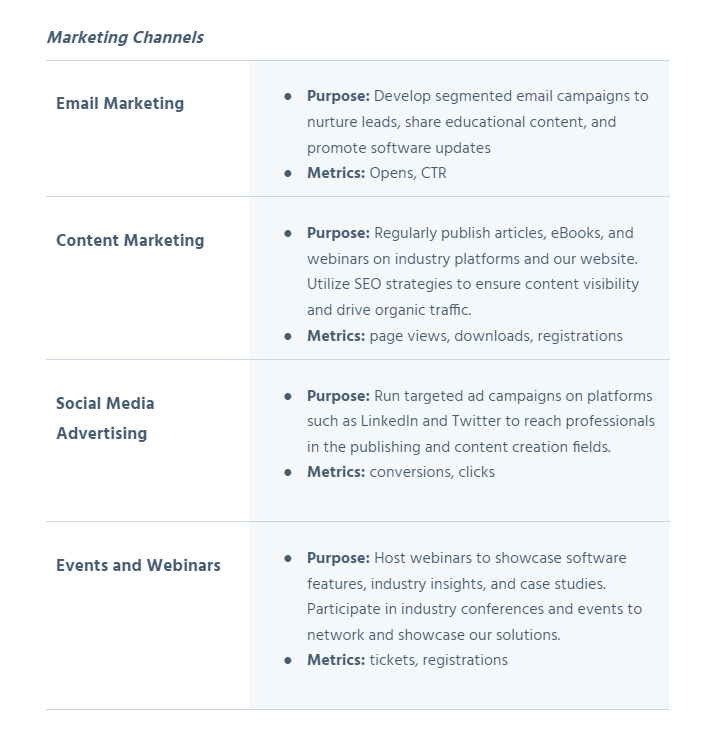
7. Marketing Technology
As technology becomes increasingly sophisticated, choosing the right marketing tools for your company requires a strategic and thorough approach.
Now, you can’t get the first tool that “looks good” to you without asking around, visiting review platforms, and, more importantly, giving it a try. Spend some time testing the waters of numerous alternatives to find the one that is the perfect match for your business.
Switching tools often is time-consuming as your team members need to learn everything anew. So, try to find tools that don’t require a major investment in time or money from the start. However, they do need to add value to your marketing efforts and bring results.
Before you commit, you should:
- Assess integration capabilities
- Consider scalability as your business grows
- Evaluate user-friendly features and clean interfaces
- Plan for training and onboarding
- Ensure data security
When you find the right tools, you can add them to your marketing plan and briefly describe what each asset of your marketing mix will do for your company.
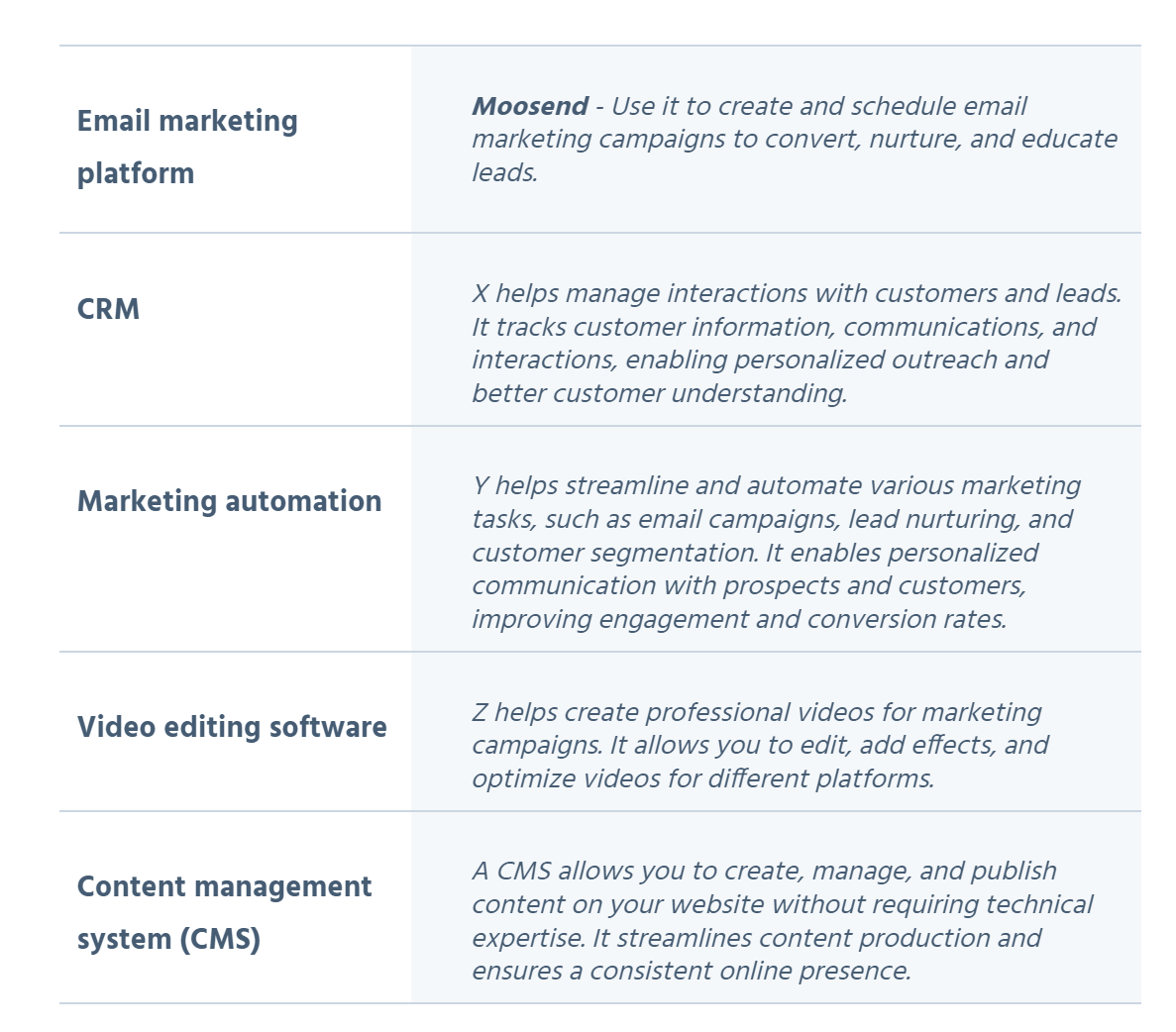
Let’s say you’ve decided that sending email campaigns aligns with your overall strategy and your audience’s preferences.
The best way to go at it is picking and testing a service that offers the majority of its features in the free trial like Moosend. Without them, there’ll be no way of knowing if it’s what you’re looking for. Not unless you make a commitment, which would be a paid plan.
Once you test it using the free trial, all that’s left is using this section to make a list of the ways in which the platform’s tools will help you reach your objectives.
By now, you know how to successfully create your marketing plan from scratch!
The next section offers actionable tips to ensure you make a comprehensive and effective plan for your organization.
Tips To Polish Your Marketing Plan
Are you ready to make a marketing plan that works? Well, before you go, here’s a checklist to guide you through the process:
1. State Your Business Mission and Values
The first step when crafting an effective marketing plan is to state your mission and company values. It’s better to do that at the beginning of your plan to give your reader core information about your company.
This way, you immediately answer the “why” before the “how.” This doesn’t mean you should add every little detail that has to do with your brand. So, keep things short and straightforward. After all, you have plenty of room to analyze every goal and initiative in the dedicated sections of your plan.
While your mission is specific to your marketing department, it has to be aligned with your main mission statement as a brand. Try to be as specific and clear as you can without exaggerating or bragging.
For example, if your business mission is to “provide affordable sports goods,” then your marketing mission could be to attract users of a certain income. To that end, you’ll want to educate them on how to achieve better results compared to competitive products. The last step involves converting them into customers who trust your products in the long-term.
Note: This information is crucial for anyone reading this since you can educate different stakeholders about your ultimate business objective. Consequently, they’ll be able to understand your marketing goals and future plans better.
2. Establish Your KPIs
How will you and everyone involved know how to evaluate your marketing efforts? A carefully built marketing plan should clearly define how the marketing department will track the progress of its mission.
Therefore, you’ll need to identify the key performance indicators (KPIs) that measure and track the different elements of your marketing campaigns.
These indicators will help you better communicate your progress to the business leaders. Plus, they allow you to understand whether your marketing efforts yield the desired results and how they contribute to larger goals.
Usually, these KPIs have specific numbers and timelines attached to them so everyone knows what to expect and by when. But let’s take a look at potential KPIs you may set:
- Getting X new leads
- Decreasing bounce rate by X%
- Writing X more articles per week/month
- Reaching X organic page views
- Increasing customer retention by X% each year
- Getting X new followers each month on Facebook/Twitter, etc.
You will need to specify metrics in some of the sections analyzed. This is why establishing your KPIs will help you stay on track and share expectations in a measurable way.
3. Assign Responsibilities
Once you have set specific goals and decided on the content types and marketing channels, it’s time to tie activities to team members. Here’s where you should identify the teams and individuals involved in bringing your marketing plan to life.
Besides describing the desired outcome, make sure you assign each initiative and task to the most appropriate contributor. This way, every team member, leader, and other stakeholders will know what you need them to accomplish and by when.
Hopefully, you have identified the perfect fit for each task and delegate accordingly. But what action items should you assign?
- Product development
- Content production
- Marketing assets creation
- Budget allocation
- Software management and training
- KPI tracking
When you clearly define and share who is responsible for every aspect of the plan, it’s easier to bring results in, individually and at team level. It’s not about pointing fingers; it’s mostly about working together as a well-oiled machine to accomplish tasks.
4. Create an Implementation Timeline
When people make any kind of plan, they start with two crucial parameters: defining the goal and setting a timeline to make it real. Marketing plans are no different.
Creating a plan implementation timeline ensures all action items are in one place—and all team members on the same page, new content production, product launches, events, or any other project you have thought of.
The most helpful part is that everyone in your team can visit the timeline, view deadlines for each task, and check what comes next in the pipeline.
So, estimate how long it will take to complete each task on the plan and set the corresponding deadline. All contributors must understand their part and by when they need to have things done.
For smooth and transparent project management, give all contributors access to the implementation timeline.
What should you include in your marketing plan timeline? Here are the main stages for each task:
- Research and brainstorming: The first step is research. During this phase, you observe competitors, interview stakeholders, and schedule brainstorming meetings. Simply put, do everything you need to gather valuable information on how to build an effective implementation strategy.
- Planning: At this point, you should match each goal with the campaigns you’ll need to reach it. This phase includes mapping out the tasks and plugging each task into a calendar. Plus, you’ll need to discuss the budget, assigning responsibilities, and set deadlines.
- Execution: This is when things get real. When the date comes, you launch the campaign, product, and content. Basically, you’ll put the theoretical aspects of your plan into practice using content, marketing channels, and events.
- Monitoring and analysis: In this final stage, you measure the performance of your campaign. Did your efforts pay off? Did you deviate from the original plan? Once you identify where things could have gone better, you can start figuring out optimization tactics to implement in future projects.
Although such a timeline is key to every marketing plan, staying flexible is of utmost importance, too. People in your team will get sick or overwhelmed, setbacks will occur, and deadlines could be missed. Especially if you choose to create an annual marketing plan, it might become daunting.
A good choice is to pick solid project management software to predict and control the things that you can. For the rest, just try to adjust to the new circumstances and make the most of your resources.
5. Describe Your Strategy and Initiatives
In multiple sections of your marketing plan, you will put the key points of your strategy. You’ll have to explain how you’ll use each element to hit your mark.
For example, if content marketing is part of your plan, make sure to add all the necessary information to the dedicated section, such as:
- The content type: blog posts, webinars, educational videos on YouTube, infographics, and eBooks.
- The amount of content: define your content volume with daily, weekly, and monthly intervals. This parameter depends on your workflow and potential goals.
- The distribution channels: Facebook, Twitter, Instagram, LinkedIn, YouTube, or Pinterest. Will you focus on one or more channels?
- The kind of paid ads that you plan to put and on which of these channels/platforms.
- The KPIs you’ll use to monitor performance. These indicators can be organic traffic, email traffic, social media traffic, and referral traffic. You may even want to include traffic on specific product pages, blog pages, or landing pages.
Remember that your marketing plan doesn’t need to be long. Keep it informative, concise, and exciting enough to intrigue readers and make them visualize everything—from point A to point Z.
6. Clearly Define Your Plan’s Omissions
Every marketing plan aims to explain your marketing team’s focus. But it also needs to elaborate on what the marketing team won’t focus on.
For example, if there’s any aspect of your business that this plan doesn’t cater to, include them in this section.
Every marketing campaign is designed for a specific reason. As a result, it can’t possibly please everyone. Putting these omissions into your plan will help you justify your mission, buyer personas, KPIs, and content strategy.
If you want, you can create an extra section and add your omissions there. Alternatively, you can include notes at the bottom of each section to inform the reader and ensure everything is clear.
7. Adjust and Optimize
Marketing plans, even when successful, aren’t set in stone. After all, success means not taking anything for granted, challenging yourself, and refining.
Continuous optimization as your business and industry evolves is a must. You should analyze team and campaign performance to understand what worked and fix everything that didn’t. But what kind of adjustments should you do?
- Follow changing trends
- Stay informed of current and shifting customer needs
- Update outdated content and branding if needed
- Gather audience feedback
- Evaluate tools used
- Reallocate budget
- Experiment with different content types
- Find opportunities for last-minute marketing ideas
If the metrics and KPIs aren’t what you’d hope for, you should be ready to adjust your plan at any step of the way. For instance, if a marketing channel didn’t perform as expected in terms of ROI, consider reallocating resources to another channel.
Also, remember to revisit it every time you set a new objective so it reflects the shift. This way, you’ll keep your plant relevant and effective no matter what.
Creating a Comprehensive Marketing Plan
For most businesses, operating without a marketing plan can result in reduced ROI, campaigns that fail to hit the mark, and a waste of your marketing budget and resources.
Formulating a solid marketing plan can align your marketing objectives with your overarching business goals.
To truly deliver what your target audience wants, you must test different ideas and strategies, measure their success, and optimize your strategy accordingly. Optimization should be essential to your strategy as it will help you improve every aspect of your business.
To get started, you can check out our free marketing plan template and use this informative step-by-step guide to make your.
Also, how about giving Moosend a try? You can see if it’s the right fit for you, and that would be one less item on your marketing checklist.
So, go ahead and register for a free account today!
FAQs
Find answers to common questions.
1. What are the 7 elements of a marketing plan?
A comprehensive marketing plan should include 7 elements: a business summary, initiative, target market, market strategy, budget, marketing channels, and marketing technology. You can add extra sections if you like, but it’s essential to have the ones mentioned above to present your plan fully.
2. How do you write a marketing plan?
To create a marketing plan, you need to follow a few simple steps. These include:
- Stating your business’s mission and values
- Crafting an executive summary
- Establishing your KPIs
- Outlining your buyer personas
- Identifying your competition
- Describing your market strategy and initiatives
- Clearly defining your plan’s omissions
- Setting your marketing budget
- Outlining your plan’s contributors and their responsibilities
To help you, you can use a pre-made marketing plan template like Moosend’s to simplify the process.
3. What are the P’s of a marketing plan?
A marketing plan includes the 6 P’s of marketing, i.e., product, pricing, promotion, people, process, and place (distribution). You can use the 6 Ps to create your market strategy.
4. What’s the difference between a marketing plan and a business plan?
A marketing plan is a dedicated document that outlines the marketing goals and all the actions that you’ll employ to achieve them. Whereas a business plan offers a holistic overview, encompassing every aspect of a company’s operations.
This broader spectrum may include strategies for overall growth, human resources, marketing campaigns, financial issues, and operational plans.



 Published by
Published by

